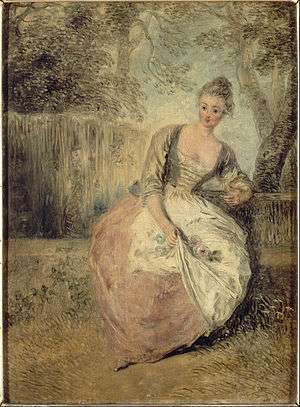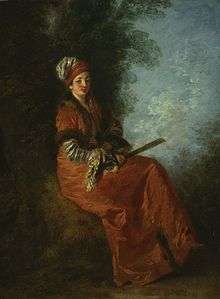The Worried Lover
| The Worried Lover | |
|---|---|
 | |
| Artist | Antoine Watteau |
| Year | c. 1715-1717 |
| Medium | oil on panel |
| Dimensions | 24 cm × 17.5 cm (9.4 in × 6.9 in) |
| Location | Salle Caroline, Musée Condé, Chantilly |

The Worried Lover (French - L'Amante inquiète) is a c.1715-1717 painting by Jean Antoine Watteau. A preparatory drawing now entitled Two studies of a seated woman (private collection) exactly matches the pose of the woman in the painting. Watteau also made an etching showing a woman seated in a very similar pose. Single figures were common in his work and also appear in La Finette, L'Indifférent and The Dreamer. According to Jean Ferré, the cut roses in the painting are a symbol of "consumed love"[1].
The painting was originally owned by abbé Haranger, canon of Saint-Germain-l'Auxerrois in Paris and one of Watteau's closest friends (he inherited many of the artist's drawings on his death). An engraving was made after the painting in 1729 by Pierre Aveline, printed on the same sheet as a print of Watteau's The Dreamer, then also owned by Haranger[2]. They were either intended as pendants to each other or - according to Pierre Rosenberg - were hung together by Haranger despite not being related[3].
The painting featured in the sale of Lebrun's collection in Paris in 1791 and entered the marquis de Maison's collection. It and the rest of that collection were then bought by Henri d'Orleans, Duke of Aumale in 1868 during his exile in London. When he returned to France he hung it in the salle Caroline of his château de Chantilly, where it remains as part of the musée Condé collection[4][5].
References
- ↑ (in French) Jean Ferré (ed.), Watteau, Madrid, 1972
- ↑ Nicole Garnier-Pelle, Chantilly, musée Condé. Peintures du xviiie siècle, Réunion des musées nationaux, coll. « Inventaire des collections publiques de France » (no 38), 1995, 222 p., p. 155-156 (notice 113)
- ↑ Pierre Rosenberg, Antoine Watteau (1684-1721), catalogue for the National Gallery of Art, Grand Palais and Schloss Charlottenburg exhibition, 1984-1985
- ↑ "JOCONDE entry".
- ↑ "Museum catalogue entry".